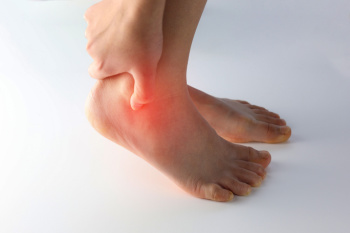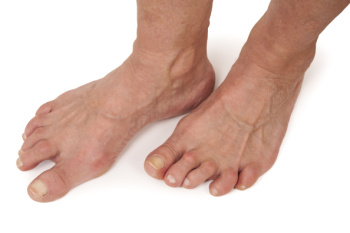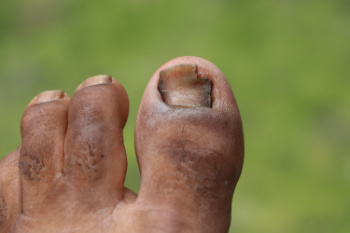Items filtered by date: October 2024
Causes of Chronic Ankle Stability

Chronic ankle instability, or CAI, is a condition where the ankle frequently gives way, often following repeated sprains. It affects those who have had previous ankle injuries, particularly athletes or individuals engaging in high-impact activities. Women, people with hypermobile joints, and those with improper rehabilitation after an initial injury are at higher risk. The causes of CAI are complex and difficult to pinpoint, involving a combination of mechanical instability from loosened ligaments and neuromuscular factors, like impaired balance and body awareness. Repeated injuries can lead to muscle weakness and poor joint control, further contributing to instability. While strength training is often recommended, research on its effectiveness in preventing or treating CAI remains inconclusive. If you have chronic ankle instability, it is suggested that you consult a podiatrist for a comprehensive treatment plan.
Ankle pain can be caused by a number of problems and may be potentially serious. If you have ankle pain, consult with Lauryn Smith-Winton, DPM from S.W. Podiatry Group. Our doctor will assess your condition and provide you with quality foot and ankle treatment.
Ankle pain is any condition that causes pain in the ankle. Due to the fact that the ankle consists of tendons, muscles, bones, and ligaments, ankle pain can come from a number of different conditions.
Causes
The most common causes of ankle pain include:
- Types of arthritis (rheumatoid, osteoarthritis, and gout)
- Ankle sprains
- Broken ankles
- Achilles tendonitis
- Achilles tendon rupture
- Stress fractures
- Bursitis
- Tarsal tunnel syndrome
- Plantar fasciitis
Symptoms
Symptoms of ankle injury vary based upon the condition. Pain may include general pain and discomfort, swelling, aching, redness, bruising, burning or stabbing sensations, and/or loss of sensation.
Diagnosis
Due to the wide variety of potential causes of ankle pain, podiatrists will utilize a number of different methods to properly diagnose ankle pain. This can include asking for personal and family medical histories and of any recent injuries. Further diagnosis may include sensation tests, a physical examination, and potentially x-rays or other imaging tests.
Treatment
Just as the range of causes varies widely, so do treatments. Some more common treatments are rest, ice packs, keeping pressure off the foot, orthotics and braces, medication for inflammation and pain, and surgery.
If you have any questions, please feel free to contact our office located in Waldorf, MD . We offer the newest diagnostic and treatment technologies for all your foot care needs.
Foot and Ankle Surgeries and Possible Complications

Common foot and ankle surgeries include bunion removal, or bunionectomy, ankle ligament repair, and Achilles tendon surgery. These procedures are often needed to correct structural deformities, repair torn ligaments, or treat chronic conditions that cause pain and dysfunction. Postoperative findings typically include swelling, bruising, and some discomfort, which are normal as the body heals. Recovery times vary depending on the procedure but often involve limited weight-bearing and targeted exercises to restore mobility and strength. Stitches are usually removed within two weeks, and patients may need to wear a protective boot or cast during the healing process. Possible complications include infection, delayed wound healing, nerve damage, or blood clots. In some cases, stiffness or reduced range of motion can occur. If you have had foot or ankle surgery, it is strongly suggested that you are under the care of a podiatrist who can closely monitor your healing.
Foot surgery is sometimes necessary to treat a foot ailment. To learn more, contact Lauryn Smith-Winton, DPM of S.W. Podiatry Group. Our doctor will assist you with all of your foot and ankle needs.
When Is Surgery Necessary?
Foot and ankle surgery is generally reserved for cases in which less invasive, conservative procedures have failed to alleviate the problem. Some of the cases in which surgery may be necessary include:
- Removing foot deformities like bunions and bone spurs
- Severe arthritis that has caused bone issues
- Cosmetic reconstruction
What Types of Surgery Are There?
The type of surgery you receive will depend on the nature of the problem you have. Some of the possible surgeries include:
- Bunionectomy for painful bunions
- Surgical fusion for realignment of bones
- Neuropathy decompression surgery to treat nerve damage
Benefits of Surgery
Although surgery is usually a last resort, it can provide more complete pain relief compared to non-surgical methods and may allow you to finally resume full activity.
Surgical techniques have also become increasingly sophisticated. Techniques like endoscopic surgery allow for smaller incisions and faster recovery times.
If you have any questions please feel free to contact our office located in Waldorf, MD . We offer the newest diagnostic and treatment technologies for all your foot and ankle needs.
Hammertoe Deformities

Hammertoe deformities are one of the most common issues affecting the lesser toes, typically causing the joint in the middle of the toe to bend downward, resembling a hammer. This condition often results from an imbalance in the muscles, tendons, or ligaments that normally keep the toes straight. Causes include wearing tight or ill-fitting shoes, injuries, or underlying conditions such as arthritis or high arches. Symptoms include pain, stiffness, and difficulty straightening the affected toe. Over time, the deformity can cause friction against shoes, leading to painful corns, calluses, and inflammation. Pain occurs due to increased pressure on the bent joint and surrounding tissues. To relieve discomfort, one can switch to wider shoes with a soft, roomy toe box and use orthotic inserts. In severe cases, surgery may be needed to realign the joint and restore normal toe function. If you have a painful hammertoe, it is suggested that you visit a podiatrist for an exam and treatment.
Hammertoe
Hammertoes can be a painful condition to live with. For more information, contact Lauryn Smith-Winton, DPM from S.W. Podiatry Group. Our doctor will answer any of your foot- and ankle-related questions.
Hammertoe is a foot deformity that affects the joints of the second, third, fourth, or fifth toes of your feet. It is a painful foot condition in which these toes curl and arch up, which can often lead to pain when wearing footwear.
Symptoms
- Pain in the affected toes
- Development of corns or calluses due to friction
- Inflammation
- Redness
- Contracture of the toes
Causes
Genetics – People who are genetically predisposed to hammertoe are often more susceptible
Arthritis – Because arthritis affects the joints in your toes, further deformities stemming from arthritis can occur
Trauma – Direct trauma to the toes could potentially lead to hammertoe
Ill-fitting shoes – Undue pressure on the front of the toes from ill-fitting shoes can potentially lead to the development of hammertoe
Treatment
Orthotics – Custom made inserts can be used to help relieve pressure placed on the toes and therefore relieve some of the pain associated with it
Medications – Oral medications such as anti-inflammatories or NSAIDs could be used to treat the pain and inflammation hammertoes causes. Injections of corticosteroids are also sometimes used
Surgery – In more severe cases where the hammertoes have become more rigid, foot surgery is a potential option
If you have any questions please contact our office located in Waldorf, MD . We offer the newest diagnostic and treatment technologies for all your foot and ankle needs.
Ankle Fracture? Don’t Wait for Treatment
Rheumatoid Arthritis and the Feet

Rheumatoid arthritis, or RA, is an autoimmune disease that causes chronic inflammation in the joints, including those in the feet and ankles. It can lead to pain, swelling, stiffness, and deformities such as hammertoes, bunions, and collapsed arches. Over time, the cartilage in the foot joints may erode, causing joint damage, reduced mobility, and difficulty walking. The constant inflammation can also affect soft tissues, leading to tendon damage and further deformities. A podiatrist plays a vital role in managing foot symptoms associated with RA. They can provide treatments like custom orthotics to support foot alignment, relieve pressure, and improve comfort. They can also prescribe anti-inflammatory medications or provide corticosteroid injections to manage pain. In severe cases, surgery may be necessary to correct deformities. If you have rheumatoid arthritis, it is suggested that you visit a podiatrist regularly for treatment to prevent further joint damage and maintain mobility.
Because RA affects more than just your joints, including the joints in your feet and ankles, it is important to seek early diagnosis from your podiatrist if you feel like the pain in your feet might be caused by RA. For more information, contact Lauryn Smith-Winton, DPM of S.W. Podiatry Group. Our doctor will assist you with all of your podiatric concerns.
What Is Rheumatoid Arthritis?
Rheumatoid Arthritis (RA) is an autoimmune disorder in which the body’s own immune system attacks the membranes surrounding the joints. Inflammation of the lining and eventually the destruction of the joint’s cartilage and bone occur, causing severe pain and immobility.
Rheumatoid Arthritis of the Feet
Although RA usually attacks multiple bones and joints throughout the entire body, almost 90 percent of cases result in pain in the foot or ankle area.
Symptoms
- Swelling and pain in the feet
- Stiffness in the feet
- Pain on the ball or sole of feet
- Joint shift and deformation
Diagnosis
Quick diagnosis of RA in the feet is important so that the podiatrist can treat the area effectively. Your doctor will ask you about your medical history, occupation, and lifestyle to determine the origin of the condition. Rheumatoid Factor tests help to determine if someone is affected by the disease.
If you have any questions please feel free to contact our office located in Waldorf, MD . We offer the newest diagnostic and treatment technologies for all your foot and ankle needs.
Toenail Fungus Treatments

Toenail fungus, or onychomycosis, is a common fungal infection that causes the toenail to become thickened, discolored, brittle, and sometimes painful. It often starts as a small yellow or white spot under the nail, and can spread if untreated. The infection thrives in warm, moist environments, making athletes and those with sweaty feet more susceptible. Treatment options vary based on the severity of the infection. Topical treatments like antifungal creams and medicated nail polishes can be effective for mild cases, though they require consistent use over several months. For more severe infections, oral antifungal tablets like terbinafine or itraconazole are commonly prescribed, which work by targeting the infection from within. In addition, laser therapy or removal of the infected nail may be used in resistant cases. If you have toenail fungus, it is suggested that you visit a podiatrist for an accurate diagnosis and treatment that best suits your condition.
For more information about treatment, contact Lauryn Smith-Winton, DPM of S.W. Podiatry Group. Our doctor can provide the care you need to keep you pain-free and on your feet.
Toenail Fungus Treatment
Toenail fungus is a condition that affects many people and can be especially hard to get rid of. Fortunately, there are several methods to go about treating and avoiding it.
Antifungals & Deterrence
Oral antifungal medicine has been shown to be effective in many cases. It is important to consult with a podiatrist to determine the proper regiment for you, or potentially explore other options.
Applying foot powder on the feet and shoes helps keep the feet free of moisture and sweat.
Sandals or open toed shoes – Wearing these will allow air movement and help keep feet dry. They also expose your feet to light, which fungus cannot tolerate. Socks with moisture wicking material also help as well.
If you have any questions please feel free to contact our office located in Waldorf, MD . We offer the newest diagnostic tools and technology to treat your foot and ankle needs.

